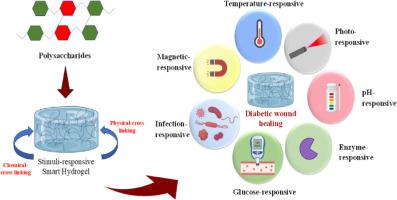Carbohydrate Polymers ( IF 10.7 ) Pub Date : 2023-11-02 , DOI: 10.1016/j.carbpol.2023.121537 Tejaswini Kolipaka 1 , Giriraj Pandey 1 , Noella Abraham 1 , Dadi A Srinivasarao 1 , Rajeev Singh Raghuvanshi 2 , P S Rajinikanth 3 , Vidya Tickoo 4 , Saurabh Srivastava 1

|
Diabetes adversely affects wound-healing responses, leading to the development of chronic infected wounds. Such wound microenvironment is characterized by hyperglycaemia, hyperinflammation, hypoxia, variable pH, upregulation of matrix metalloproteinases, oxidative stress, and bacterial colonization. These pathological conditions pose challenges for the effective wound healing. Therefore, there is a paradigm shift in diabetic wound care management wherein abnormal pathological conditions of the wound microenvironment is used as a trigger for controlling the drug release or to improve properties of wound dressings. Hydrogels composed of natural polysaccharides showed tremendous potential as wound dressings as well as stimuli-responsive materials due to their unique properties such as biocompatibility, biodegradability, hydrophilicity, porosity, stimuli-responsiveness etc. Hence, polysaccharide-based hydrogels have emerged as advanced healthcare materials for diabetic wounds. In this review, we presented important aspects for the design of hydrogel-based wound dressings with an emphasis on biocompatibility, biodegradability, entrapment of therapeutic agents, moisturizing ability, swelling, and mechanical properties. Further, various crosslinking methods that enable desirable properties and stimuli responsiveness to the hydrogels have been mentioned. Subsequently, state-of-the-art developments in mono- and multi- stimuli-responsive hydrogels have been presented along with the case studies. Finally regulatory perspectives, challenges for the clinical translation and future prospects have been discussed.
中文翻译:

用于糖尿病伤口愈合的刺激响应性多糖智能水凝胶:设计方面、制备方法和监管视角
糖尿病会对伤口愈合反应产生不利影响,导致慢性感染伤口的发展。这种伤口微环境的特征是高血糖、过度炎症、缺氧、pH值变化、基质金属蛋白酶上调、氧化应激和细菌定植。这些病理状况对伤口的有效愈合提出了挑战。因此,糖尿病伤口护理管理发生了范式转变,其中伤口微环境的异常病理条件被用作控制药物释放或改善伤口敷料性能的触发因素。由天然多糖组成的水凝胶由于其独特的性质,如生物相容性、生物可降解性、亲水性、孔隙率、刺激响应性等,在伤口敷料和刺激响应材料方面显示出巨大的潜力。因此,基于多糖的水凝胶已成为糖尿病伤口的先进医疗材料。在这篇综述中,我们提出了基于水凝胶的伤口敷料设计的重要方面,重点是生物相容性、生物降解性、治疗剂的包埋、保湿能力、膨胀和机械性能。此外,已经提到了能够使水凝胶具有所需特性和刺激响应性的各种交联方法。随后,单刺激响应水凝胶和多刺激响应水凝胶的最新进展与案例研究一起呈现。最后讨论了监管观点、临床转化的挑战和未来前景。































 京公网安备 11010802027423号
京公网安备 11010802027423号